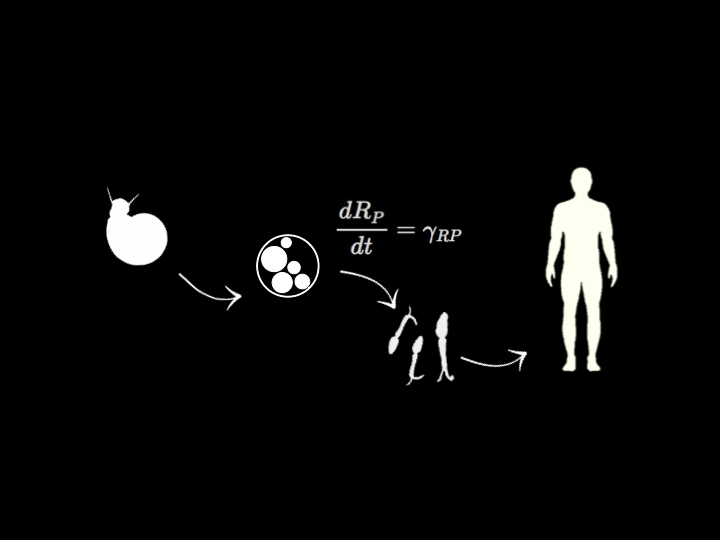Individual-based model (IBM) for Schistosoma mansoni parasite and Biomphalaria glabrata snail host population infection based on a within-host dynamic energy budget (DEB) model and a between host exposure and transmission model.
Host and parasite individual-level energetics and their ecology are captured by the mechanistic energy budget model and interactions among hosts and parasites are captured by the disease tranmission model. The global model simulates how resource use by a size-structured host population drives timing and severity of human-infectious parasite output throughout the schistosomiasis transmission season.
Outputs for the model:
Malishev M and Civitello DJ (2020) Modelling how resource competition among snail hosts affects the mollusciciding frequency and intensity needed to control human schistosomes, Functional Ecology, https://doi.org/10.1111/1365-2435.13602.
Malishev M and Civitello DJ (2019) Linking bioenergetics and parasite transmission models suggests mismatch between snail host density and production of human schistosomes, Integrative and Comparative Biology, 59(5), 1243–1252, https://doi.org/10.1093/icb/icz058.
Malishev M and Civitello DJ (2019) Fewer, fatter snail hosts make more human schistosome parasites than many, starved ones, International Society for Ecological Modelling 2019, ISEM2019, Oct 1–5, Salzburg, Austria.
Files:
.R
.html
.pdf
.nlogo
.c
.o
.so
.sh
Updates:
For NetLogo version updates, see the Info tab within the NetLogo file 'DEB_INF_GUTS_IBM.nlogo'.
For R version updates, see the header within the R file 'DEB_IBM.R'.
Download the instructions for your operating system
Notation follows the standard DEB notation, except in the following aspects:
- Rates are indicated with '_rate' rather than a dot
- 'ee' is scaled reserve density of hosts in
Netlogo
Host
Hosts incur costs from infection through damage density delta and cumulative hazard rate H.
Parasite
The number of free-living miracidia in the environment is based on a probability function (multinomial distribution) of surviving miracidia, miracidia that successfully infected hosts, and unsuccessful miracidia that died.
Table 1. Definitions of model parameters for individual hosts and parasites. Dimensions and units: -, dimensionless; cm, centimetres; d, days; J, joules; L, length.
| Parameter | Definition | Dimension (unit) |
Environment |
|---|---|---|---|
| L | structural length | cm | NetLogo |
| ee | scaled reserve density | J (cm3) | NetLogo |
| D | host development | mg C | NetLogo |
| RH | energy in reproduction buffer | J | NetLogo |
| DAM | starvation-related damage | t (d-1) | NetLogo |
| HAZ | starvation-related hazard rate | t (d-1) | NetLogo |
| LG | shell length | L (cm) | NetLogo |
| age | age of egg (hatches at 7 days) | t (d-1) | NetLogo |
| P | parasite biomass | cm3 | NetLogo |
| RPP | energy in parasite reproduction | J | NetLogo |
Table 2. Definitions of model parameters of the simulation model environment. Dimensions and units: N, number.
| Parameter | Definition | Dimension (unit) |
Environment |
|---|---|---|---|
| F | periphyton (food) density | N | NetLogo |
| M | total number of miracidia | N | NetLogo |
| Z | cercarial density | N | NetLogo |
| G | total number of eggs | N | NetLogo |
For running Netlogo from R on Mac OSX. See the Instructions for Mac OSX page for a detailed breakdown of the troubleshooting steps.
1️⃣ Installing compiler toolchain for Mac OSX
2️⃣ If you get an rJava error, run the following in Terminal:
sudo ln -s $(/usr/libexec/java_home)/jre/lib/server/libjvm.dylib /usr/local/lib
(src: https://stackoverflow.com/questions/30738974/rjava-load-error-in-rstudio-r-after-upgrading-to-osx-yosemite and #http://paulklemm.com/blog/2015-02-20-run-rjava-with-rstudio-under-osx-10-dot-10/)
3️⃣ For running java tests for Mac OSX, see the Instructions for Mac OSX documentation.
Matt Malishev
🔍 Website
🐦 @darwinanddavis
📧 matthew.malishev [at] gmail.com

